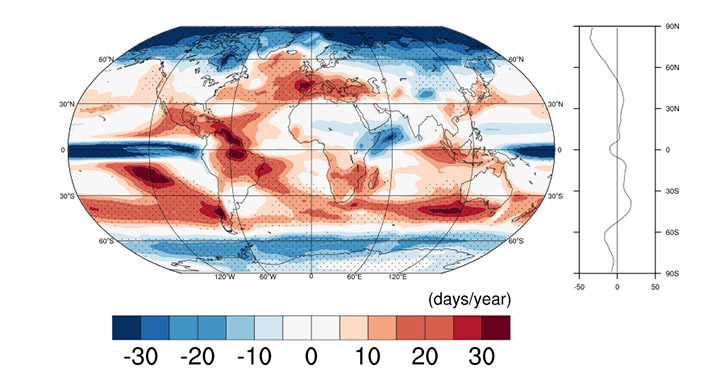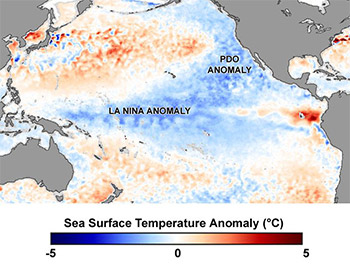
By:
- Robert Monroe
Published Date
By:
- Robert Monroe
Share This:
How the West Gets Drier
Scripps Institution of Oceanography key to new perspectives on human-caused climate change

As simulated by computer models, the average mean change in frequency of dry days (days/year) by 2060-2089, relative to the historical period 1960-1989, factoring in anthropogenic climate change. Image by Scientific Reports
New studies involving researchers at Scripps Institution of Oceanography at UC San Diego project that human influences will lead to a drier world as the 21st century progresses.
On Sunday, a team of researchers led by a former Scripps postdoctoral researcher offered a new explanation for why Earth’s tropical belt, bounded by the tropics of Cancer and Capricorn, has progressively expanded since the late 1970s. The tropical belt study appears the journal Nature Geosciences.
Robert J. Allen, now an assistant professor of climatology in UC Riverside’s Department of Earth Sciences, led a NASA-funded study that found the recent widening of the tropical belt is primarily caused by multi-decadal sea surface temperature variability in the Pacific Ocean. This variability includes the Pacific Decadal Oscillation (PDO), a pattern of Pacific climate variability that switches roughly every 30 years between two different circulation patterns in the North Pacific Ocean. The researchers say anthropogenic pollutants are another influence that modifies the PDO. The result is an expansion of the range of subtropical deserts that stay dry year-round and the pushing of storm tracks closer to the poles.

This image shows the sea surface temperature anomaly in the Pacific Ocean from April 14–21, 2008. Places where the Pacific was cooler than normal are blue, and places where the ocean was warmer than normal are red. The shift in the Pacific Decadal Oscillation can have significant implications for global climate. Image by Jesse Allen (NASA), AMSR-E data processed and provided by Chelle Gentemann and Frank Wentz, Remote Sensing Systems.
Several explanations for the tropical belt widening have been proposed in recent years, such as radiative forcing due to greenhouse gas increase and stratospheric ozone depletion.
“Prior analyses have found that climate models underestimate the observed rate of tropical widening, leading to questions on possible model deficiencies, possible errors in the observations, and lack of confidence in future projections,” said Allen. “Furthermore, there has been no clear explanation for what is driving the widening.”
Allen and colleagues, including Scripps atmospheric science researcher Joel Norris, found that the PDO is a more significant variable than previously realized.
“Although this widening is considered a ‘natural’ mode of climate variability, we also show that anthropogenic pollutants have driven trends in the PDO,” Allen said. “Thus, tropical widening is related to both the PDO and anthropogenic pollutants.”
Tropical widening is associated with several significant changes in climate, including shifts in large-scale atmospheric circulation and storm tracks. In Southern California, tropical widening may be associated with less precipitation.
Semi-arid regions including the Mediterranean, the southwestern United States and northern Mexico, southern Australia, southern Africa, and parts of South America also face the prospect of greater dryness. An increase in the width of the tropics could increase the area affected by tropical storms (hurricanes), or could change climatological tropical cyclone development regions and tracks.
A reversal of the cycle or a global clean-up of air pollution would also influence the dimensions of the tropical belt, said Norris.
“One thing we found in the study is evidence that there was tropical contraction from the 1950s to 1970s so that would suggest if the PDO shifts back again that there might be tropical contraction,” said Norris.
A second study by a team of Scripps researchers released on March 13 indicates that the number of days in a year without rain is poised to increase substantially in the Amazon, Mediterranean and other regions around the globe. There could be as many as 30 more “dry days” in these regions, while climate models suggest that places like California could receive five to 10 fewer days of rain per year.
The dry days study appears in Scientific Reports, the open-access journal from Nature Publishing Group. Suraj Polade, a postdoctoral researcher at Scripps, led that study. He said that one of the implications of this finding is that annual rainfall could become less reliable in drying regions as annual averages will be calculated over a smaller number of days. The 28 models used by the team showed agreement in many parts of the world on the change in the number of dry days those regions will receive.
“Looking at changes in the number of dry days per year is a new way of understanding how climate change will affect us that goes beyond just annual or seasonal mean precipitation changes, and allows us to better adapt to and mitigate the impacts of local hydrological changes,” said Polade, who works with Scripps climate scientists Dan Cayan, David Pierce, Alexander Gershunov and Michael Dettinger, who are co-authors of the study.
“Changes in intensity of precipitation events and duration of intervals between those events will have direct effects on vegetation and soil moisture,” said Stephen Jackson, director of the U.S. Department of the Interior Southwest Climate Science Center, which co-funded the study. “Polade and colleagues provide analyses that will be of considerable value to natural resource managers in climate adaptation and planning. Their study represents an important milestone in improving ecological and hydrological forecasting under climate change.”
Share This:
You May Also Like
Stay in the Know
Keep up with all the latest from UC San Diego. Subscribe to the newsletter today.


